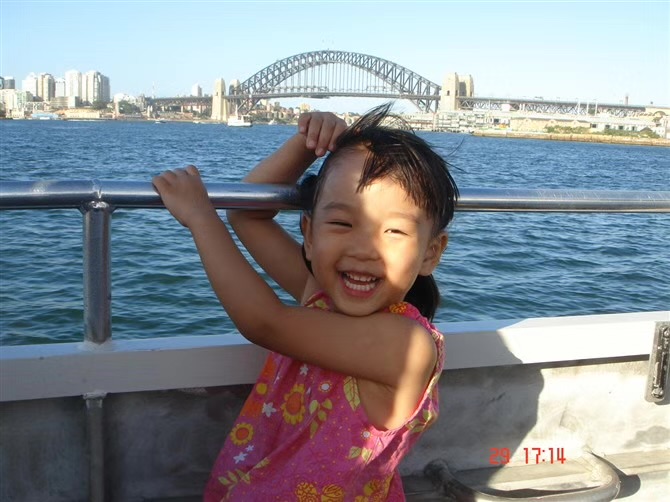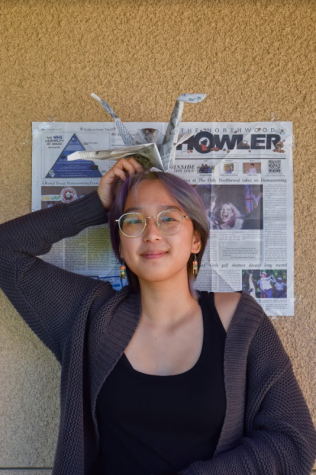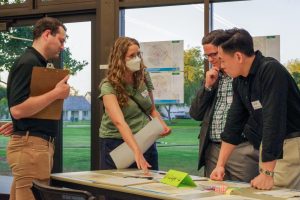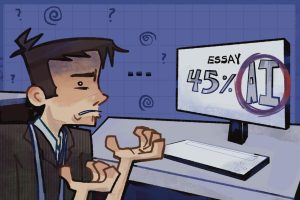Crossing from one end of the bridge to the other
May 26, 2023
In Rita Lai’s recollection of The High School Experience™, the narrator’s loss of adolescent naivety as a transition into crushing fear of the future is conveyed through the cumulative anecdotes of various classes and extracurricular activities, particularly The Howler as a demonstration of how community connections can curb such a fear.
In the initial stage of high school, the narrator embodies the typical teenager, incredibly insecure and self-conscious yet somehow holding the belief that one is at the peak of existence. For instance, a common thought that runs through her mind while cramming for exams is, “I’m literally going to jump off the school roof.” The consonance present in “off” and “roof” contribute to an aggressive tone, as these sound devices are reminiscent of a spitting motion, which when paired with the insistent and despairing diction of her monologues reveals a deficiency in her work ethic and the general trend of student behavior during the time period.
While fearing the consequences of her own passivity, she also makes little effort towards putting her fears into action, indicating a cognitive dissonance between what she hopes to achieve and what she actually achieves. This indirectly characterizes her as overly optimistic and perhaps delusional in believing she can get away with procrastination, as she has not yet learned the future consequences of sleep deprivation (permanent dark eye circles) and last-minute work (grades reflective of poor quality).
Fortunately, her single-minded focus on academic issues comes to a halt during mid-March 2020, the announcement of the beginning of quarantine. As her hand-written diary entry on March 13 states, “Holy crap. School is cancelled for the next two weeks, then it will be spring break.” There is a sense of dramatic irony, emphasizing the narrator’s naviety in believing the break will only be two weeks. The forced period of isolation also affirmed her superiority complex towards underclassmen as she derided those who were unable to experience the ego-crushing experience of middle school. Her infiltration into The Howler Zoom meetings also foreshadows the significance that the extracurricular will hold for her further along the line.
Eventually, as the years pass by in The High School Experience™, the narrator comes to a realization that high school is not merely a stepping stone to the next stage of life, but a time that must be individually cherished for encompassing her last moments of youth freedom. The summer before her senior year, the narrator chops off half of her hair while watching a Brad Mondo video and begins the long-lasting cycle of subjecting it to rounds of bleaching and color.
Hair dye, in this instance, can be interpreted as an extended metaphor for new experiences. In the same way that she’ll never be able to remove the stains of green dye from her hair, she will similarly feel the effect of every interaction and connection echoing in her identity. Choosing increasingly vibrant colors of dye parallels her efforts to branch out in unique opportunities only available during high school, such as her voluntary participation of staying on campus until 9 p.m. for tech theater and the struggles she faces in waking up for period one orchestra.
Furthermore, the time she commits to The Howler can be quantified in the four periods she’s missed in total this year, as compared to the 20 for AP Statistics. The stark juxtaposition between the attendance rates for these two classes demonstrates a greater willingness to subject oneself to monotony when surrounded by an uplifting community in addition to the propensity to have excessive “dentist appointments” during seventh period in particular. Contrary to popular interpretations, “dentist appointments” is not in fact complete verbal irony, as even if it may not reflect the full truth, the narrator attests to having at least two real unavoidable tooth cleaning sessions. Ambiguity in the narrator’s actions mirrors the uncertainty of the passage of time as an adolescent, indicative of how despite the dubious nature of school attendance, it remains as a pressing constant, offering both pain and security in the routine schedule.
Despite the narrator’s hopeful belief that she’s sufficiently matured both emotionally and mentally during the past four years, her adherence to the AP Lit essay format illustrates her lingering juvenile attachment to high school. She still struggles in learning to use a planner, in converting Class Aquaintances to Outside Friends, in managing anger during the lunch line; and among countless other incomplete lessons, the most difficult is accepting the end to all this.

























































